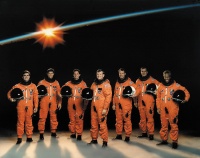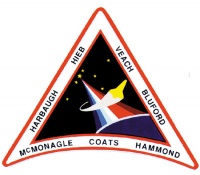STS-39
From The Space Library
 | |
| Organization | NASA-Office of Space Flight (United States) |
|---|---|
| Mission type | Human Crew |
| Launch date | April 28, 1991 |
| Launch vehicle | Space Shuttle |
| Launch site | Cape Canaveral, United States |
| COSPAR ID | 1991-031A |
| Inclination | 57 degrees |
| Experiments | Here |
| Alternate Names | 21242 |
| Additional Information | Here |
| Data Collection | Here |
| Payload Mass Up | 9712 kg |
| Payload Mass Down | 9357.27 kg |
| Orbiter | Discovery |
| Lift Off Mass | 2,051,226.36 kg |
| Orbiter Weight at Liftoff | 112,266.36 kg |
| Orbiter Weight at Landing | 95,823.18 kg |
| Landed | Runway 15 at Kennedy Space Center, Fla. |
| Orbits of Earth | 134 |
| Orbital Altitude | 140 nautical miles (161 statute miles) |
Contents |
[edit] Crew
- Commander: Michael L. Coats
- Pilot: L. Blaine Hammond Jr.
- Payload Commander:
- Mission Specialist 1: Gregory J. Harbaugh
- Mission Specialist 2: Donald R. McMonagle
- Mission Specialist 3: Guion S. Bluford Jr.
- Mission Specialist 4: Charles L. (Lacy) Veach
- Mission Specialist 5: Richard J. Hieb
- Payload Specialist 1:
- Payload Specialist 2:
ISS/Mir Crew Transport
[edit] Mission
STS-39 was the 12th shuttle Discovery flight and the first unclassified military mission. The purpose of the flight was to gather data needed to develop spaceborne sensors and software that could recognize missile or reentry vehicle signatures as they flew through or above the atmosphere. To that end, Discovery carried Air Force and Strategic Defense Initiative-sponsored instruments to observe gases in the upper atmosphere, emissions from the shuttle engines, and chemicals released from co-orbiting subsatellites. The scheduled observations required the crew to work around the clock in 12-hour shifts. Mission Commander was Michael L. Coats, the Pilot was Blaine Hammond Jr., and Mission Specialists were Gregory L. Harbaugh, Donald R. McMonagle, Guion S. Buford, C. Lacy Veach and Richard J. Hieb. The primary Air Force payload -- a CIRRIS infrared telescope, secondary sensors and an ultraviolet camera -- was activated 3 hours into the flight. Two failed tape recorders curtailed data collection until the crew rigged a bypass on mission day 7. The Infrared Background Signature Survey (IBSS) instrument, mounted on the Shuttle Pallet Satellite (SPAS), was deployed on May 1. A pointing error stalled the experiment for 9 hours. With IBSS/SPAS in position, the shuttle undertook a series of fast Orbital Maneuvering System (OMS) and Reaction Control System (RCS) burns. During the 27-mn sequence, and 3 encores, the IBSS photographed Discovery's exhaust plumes. The free-flyer subsequently observed chemicals released from three subsatellites ejected from the cargo bay. A fifth satellite was deployed several hours before landing. Discovery's return to earth was rerouted to KSC due to high winds at Edwards AFB. It touched down on the concrete runway at 18:55 May 6, after 8 days, 7 hrs, 22 mns in orbit. Despite the technical problems, the returns from STS 39 surpassed expectations and will serve as a database for missile defense system development.
[edit] EVA
[edit] Payload
Infrared Background Signature Survey (lBSS); Air Force Program (AFP)-675; Space Test Payload (STP)-I; Multi-Purpose Experiment Canister (MPEC); Cloud Logic to Optimize Use of Defense Systems (CLOUDS)-1A; Radiation Monitoring Equipment (RME)-lll
[edit] Books about the Space Shuttle Program
Buy This Book Click here |
Buy This Book here |
Buy This Book Click here |
Buy This Book Click here |





